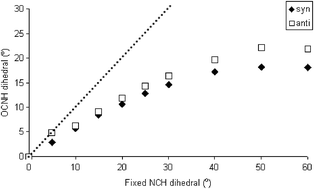Ab initio and density functional theory (DFT) calculations on some model systems are presented to assess the extent to which intermolecular hydrogen bonding can affect the planarity of amide groups. Formamide and urea are examined as archetypes of planar and non-planar amides, respectively. DFT optimisations suggest that appropriately disposed hydrogen-bond donor or acceptor molecules can induce non-planarity in formamide, with OCNH dihedral angles deviating by up to ca. 20° from planarity. Ab initio energy calculations demonstrate that the energy required to deform an amide molecule from the preferred geometry of the isolated molecule is more than compensated by the stabilisation due to hydrogen bonding. Similarly, the NH2 group in urea can be made effectively planar by the presence of appropriately positioned hydrogen-bond acceptors, whereas hydrogen-bond donors increase the non-planarity of the NH2 group. Small clusters (a dimer, two trimers and a pentamer) extracted from the crystal structure of urea indicate that the crystal field acts to force planarity of the urea molecule; however, the interaction with nearest neighbours alone is insufficient to induce the molecule to become completely planar, and longer-range effects are required. Finally, the potential for intermolecular hydrogen bonding to induce non-planarity in a model of a peptide is explored. Inter alia, the insights obtained in the present work on the extent to which the geometry of amide groups may be deformed under the influence of intermolecular hydrogen bonding provide structural guidelines that can assist the interpretation of the geometries of such groups in structure determination from powder X-ray diffraction data.

This article is Open Access
 Please wait while we load your content...
Something went wrong. Try again?
Please wait while we load your content...
Something went wrong. Try again?


 Please wait while we load your content...
Please wait while we load your content...